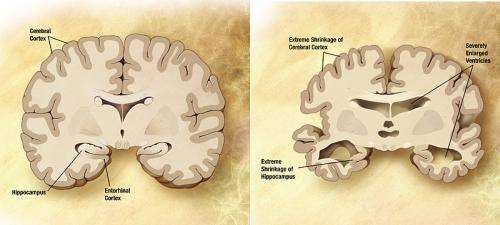Diagram of the brain of a person with Alzheimer's Disease. Credit: Wikipedia/public domain.
Researchers have characterized three different brain imaging changes in individuals with Down syndrome, who are at very high risk for development of Alzheimer's disease, even before the onset of progressive memory and thinking problems. Their findings could help set the stage to evaluate promising treatments to slow down or prevent the onset of Alzheimer's symptoms in these individuals, according to a study published in Alzheimer's & Dementia.
The scientists at Banner Sun Health Research Institute (BSHRI) and Banner Alzheimer's Institute (BAI) have also identified the approximate age—about 35 to 40—at which Alzheimer's-associated brain imaging changes occur in the Down's population, which could help pinpoint when to initiate investigational treatments in those trials.
Almost 80 percent of Down syndrome individuals will develop Alzheimer's, due partly to improved medical care that has led people with Down's to live longer and develop Alzheimer's-related brain changes. Down syndrome, also known as Trisomy 21, is caused when people have three copies of the twenty-first chromosome, which carries a gene for the amyloid precursor protein (APP). This results in over-expression of APP, leading to the over-production of amyloid, a protein linked to Alzheimer's disease, the deposition of amyloid plaques, and the development of memory and thinking problems at relatively young ages.
"The number of people with Down syndrome who go on to Alzheimer's symptoms has tripled in the last twenty years," said Marwan Sabbagh, the study's lead researcher and director of BSHRI. "There is a growing need to find interventions to treat and prevent Alzheimer's in these individuals, and there is an opportunity to do so in a way that could help find effective Alzheimer's prevention therapies for everyone."
Sabbagh and his team used positron emission tomography (PET) imaging to detect the accumulation of beta-amyloid, as well as a pattern of reduced brain activity that is characteristic of Alzheimer's disease. In addition, magnetic resonance imaging (MRI) scans were used to measure gray matter volume in three types of study participants: five participants with Down syndrome who already demonstrate clinical features of Alzheimer's, 12 participants with Down syndrome who have not yet shown clinical evidence of Alzheimer's and nine healthy participants who did not have either Down syndrome or Alzheimer's.
"We and other researchers have been interested in detecting and tracking Alzheimer's, starting before the onset of cognitive impairment in individuals at genetic risk for the disease," said Eric Reiman, M.D., executive director of BAI, a leader of the Alzheimer's Prevention Initiative (API), and senior researcher for this study. "We have used this approach to help launch Alzheimer's prevention trials in people with other genetic risk factors, and we hope that the same approach can help empower people with Down syndrome in the fight against this disease."
Comparing the three groups, researchers found that the Down syndrome with Alzheimer's group had significantly higher accumulation of beta-amyloid, lower brain activity in brain regions known to be affected by Alzheimer's and smaller gray matter volumes than the other two groups.
In comparing measurements between the group with Down syndrome without Alzheimer's dementia and the healthy volunteer group, researchers also found more accumulation of amyloid protein in the Down syndrome participants, even though these participants were not yet exhibiting Alzheimer's symptoms. This finding is consistent with previous evidence showing that amyloid deposition precedes clinical symptoms of Alzheimer's.
The findings led Sabbagh and his team to conclude that amyloid deposition begins around 35 to 40 years of age, before the onset of progressive memory and thinking problems.
The research team has received financial support to determine how these and other brain imaging and cognitive features of Alzheimer's disease change over time in people with Down syndrome, information that will help inform the design of future prevention trials in this population.
Provided by GYMR




















